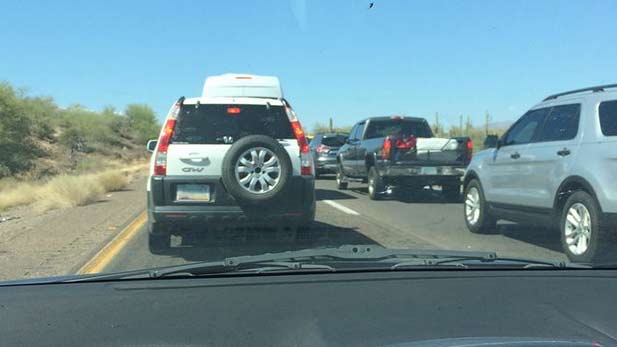 Interstate 17 traffic, as seen from the driver's vantage.
Interstate 17 traffic, as seen from the driver's vantage.By Stina Sieg, KJZZ
This Thanksgiving holiday, AAA estimates nearly 50 million Americans will be traveling. If you’re driving on Arizona’s Interstate 17 during that time, it might feel like all of them are right there with you.
I-17, which connects Phoenix to Flagstaff, is notorious for traffic snarls and closures, especially in one small town, whose name you might recognize from nightly traffic reports.
Black Canyon City, 40 miles north of Phoenix, is famous for two things: delicious pie from the local diner and epic traffic congestion.
Sometimes, people can be stuck for miles and hours on this vital stretch of road, which has few frontage roads and even fewer alternate routes. But locals here have a way of avoiding the crush of cars.
“We don’t go north on Fridays, and we don’t go south on Sundays,” Black Canyon City resident David Peplinski said.
The backup is just that predictable, Peplinksi said, as he sipped a soda at the bar at Rock Springs Café. That’s the local haunt that makes the town’s famous pie, and becomes a haven to travelers escaping traffic that sometimes stretches for 20 miles.
Paintings of cowboys were on the walls, a giant taxidermied polar bear was standing the corner, and the place was packed with locals – all with their own ideas about how to deal with the traffic.
Mike Erickson, who has lived in Black Canyon City for 10 years, said ideally a frontage road would be great.
“I think it would be nice if you could just make change lanes," Erickson said. "The northbound lane is blocked. You should be able to go southbound for a couple of miles to get around it."
Retired Arizona Highway Patrolman Richard Smith had a popular opinion: widen the road, by least one lane, north of Anthem.
“Because there’s just too much traffic for too little a road,” Smith said.
That would be around 30,000 cars a day in the Black Canyon City area and more than 50,000 on the weekends, according to the Arizona Department of Transportation.
Dallas Hammit, deputy director for transportation and the state engineer, said the number of cars has been increasing steadily in recent years, but when it comes to the idea of widening the roadway, “the pie isn’t big enough.”
Meaning the pot of money ADOT has can’t pay for a giant project like that, at least not all at once.
Every year, Hammit said, ADOT has about $300 million to use in greater Arizona, which includes I-17. That might sound like a lot, but that money has to pay for both new projects and maintenance.
Hammit estimates it would cost more than $100 million to add a lane from Anthem to Cordes Junction.
“So, it would take multiple years, or we don’t do any maintenance of our system for multiple years,” he said.
That would entail multiple years of no upkeep of roadways or bridges, which simply is not an option. And besides, Hammit said, it’s not really the road that’s the problem. It’s people.
“About 90 to 95 percent of crashes are behavior,” he said.
Meaning, the road’s not usually at fault. The drivers are. Maybe they're texting and swerve into another lane. Maybe they're going too fast around a curve. Maybe they're tipsy and don’t realize it.
The people of Black Canyon City have seen it all.
Back at the Rock Springs Café, 80-year-old Jean Kessel recounts one of the many serious accidents that have happened on I-17 since she moved to town more than a decade ago.
“We had a lady who tried to save a cow that happened to get on the freeway,” she said. That situation ended in the woman’s death and, of course, a road closure.
Like the other locals, Kessel said she’s never been in a crash in the area.
Kessel said she and her friends know how to navigate these roads, unlike what they call "flatlanders," out of Phoenix.
She said she thinks they don’t get how dangerous this road can be. “This is a serious situation,” Kessel said, her big smile suddenly getting serious. “Slow down.”
Kessel’s hope is that ADOT puts up more warning signs, alerting people to the same thing. And she's getting her wish.
ADOT’s planning to install new electronic warning and speed feedback signs next year. A widening project is a possible long-term goal, but has not yet been planned.

By submitting your comments, you hereby give AZPM the right to post your comments and potentially use them in any other form of media operated by this institution.